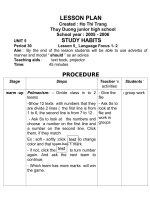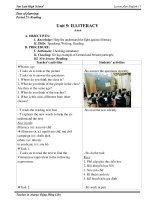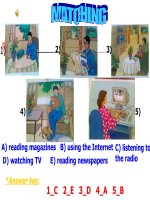READING text unit 5 English
Bạn đang xem bản rút gọn của tài liệu. Xem và tải ngay bản đầy đủ của tài liệu tại đây (198.13 KB, 2 trang )
MONETARY POLICY AND FISCAL POLICY
Monetary policy and fiscal policy both have great impacts on economic development throughout the world.
These policies work hand in hand to stimulate or depress economic activity.
MONETARY POLICY
Monetary policy is the economic policy laid down by the central bank. This policy determines the size and
rate
of growth of the money supply, which in turn affects
interest rates. Monetary policy is maintained through
actions
such as modifying the interest rate, buying or selling
government bonds, and changing the amount of money
banks are
required to keep in the vault (bank reserves).
and
Broadly speaking, there are two types of monetary
policy, expansionary and contractionary. Expansionary
monetary policy increases the money supply in order to
lower unemployment, boost private-sector borrowing
consumer spending, and stimulate economic growth.
Contractionary monetary policy slows the rate of
growth in the money supply or outright decreases
the
money supply in order to control inflation; while
sometimes necessary, contractionary monetary policy can
slow
economic growth, increase unemployment and depress
borrowing and spending by consumers and businesses.
Central banks use a number of tools to shape monetary policy. There are three main monetary policy tools:
open market operations, the discount rate and the reserve requirement.
Open Market Operations are when the central bank buys or sells securities. These are bought from or sold
to the country's member banks. The central bank buys securities when it wants expansionary monetary
policy. It sells them when it executes contractionary monetary policy.
Reserve Requirement refers to the money banks must keep on hand overnight. They can either keep the
reserve in their vaults or at the central bank.
Discount Rate is the rate that central banks charge its members to borrow at its discount window.Since the
rate is high, banks only use this if they can't borrow funds from other banks.
These monetary policy tools work together to sustain healthy economic growth.
FISCAL POLICY
Fiscal policy can be defined as the government’s policy to influence an economy through the use of
taxation and government spending. This type of policy is used when policy-makers believe the economy
needs outside help in order to adjust to a desired point. Typically a government has a desire to maintain
steady prices, an employment level, and a growing economy. If any of these areas are out of sorts, some
type of fiscal policy may be in order.
Fiscal policy can be used in order to either stimulate a sluggish economy or to slow down an economy that
is growing at a rate getting out of control. Fiscal policy directly affects the aggregate demand of an
economy.
There are two types of fiscal policy: Expansionary and Contractionary.
When an economy is in a recession, expansionary fiscal policy is in order. Typically this type of fiscal policy
results in increased government spending and/or lower taxes, which would help an economy grow.
Contractionary fiscal policy is essentially the opposite of expansionary fiscal policy. When an economy is in
a state where growth is at a rate getting out of control (causing inflation and asset bubbles),
contractionary fiscal policy can be used to reduce government spending and/or increase taxes. This would
bring the economy to a more sustainable level.
There are two main tools of Fiscal Policy. The first tool is taxation. That includes income, capital gains from
investments, property, and sales. Taxes provide the income that funds
the government.
The second tool is government spending.That includes subsidies, transfer
payments including welfare programs, public works projects, and
government salaries.
The two fiscal policy tools help the government monitor and influence
the economy.









